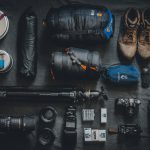Camping and wildlife photography are a perfect combination for those who want to immerse themselves in nature and capture its beauty through the lens of a camera. Whether you’re an amateur photographer or a seasoned professional, camping provides abundant opportunities to capture stunning wildlife photographs in their natural habitats. In this article, we will explore essential tips and techniques for wildlife photography during camping trips, enabling you to capture breathtaking images and preserve the magic of the natural world.
Research and Plan
Before embarking on your camping and wildlife photography adventure, it’s essential to research and plan your trip effectively. Here are some key considerations:
- Location: Choose a camping destination known for its diverse wildlife population. Research national parks, wildlife reserves, or camping areas that offer a variety of animal species to photograph.
- Seasons and Migration Patterns: Familiarise yourself with the migration patterns and behaviours of the wildlife you intend to photograph. This knowledge will help you plan your trip during the most active and visually appealing times.
- Local Guides and Experts: Seek advice from local guides or wildlife experts who possess in-depth knowledge about the area and its wildlife. They can provide valuable insights into the best locations and times for wildlife photography.
- Weather Conditions: Be aware of the weather conditions during your camping trip, as they can significantly impact animal behaviour and the overall photographic opportunities.
Essential Gear for Wildlife Photography
To capture stunning wildlife photographs, you need the right equipment. Here are some essential gear recommendations:
- Camera Body: Invest in a camera body with a fast burst rate and excellent autofocus capabilities to capture animals in motion.
- Telephoto Lens: A telephoto lens with a long focal length is essential for wildlife photography, allowing you to capture detailed images from a safe distance. Consider a lens with a focal length of 300mm or more.
- Tripod or Monopod: A sturdy tripod or monopod is beneficial for stabilizing your camera and lens, especially when shooting in low light or using long focal lengths.
- Camera Bag: A reliable camera bag with sufficient padding and compartments will protect your equipment during camping trips.
- Extra Batteries and Memory Cards: Carry extra batteries and memory cards to ensure you don’t miss any precious moments due to equipment limitations.
- Lens Cleaning Kit: Keep your lenses clean and free from dust and smudges using a lens cleaning kit.
- Camera Rain Cover: If you anticipate inclement weather, a camera rain cover will protect your gear from moisture.
Understanding Animal Behaviour
To capture compelling wildlife photographs, it’s crucial to understand animal behavior and anticipate their movements. Consider the following tips:
- Patience and Observation: Observe the animals from a safe distance to understand their behaviour patterns. Patiently wait for the right moment to capture their natural interactions and unique behaviours.
- Respect and Distance: Give wildlife their space and avoid disturbing their natural routines. Respect their boundaries and never put yourself or the animals in danger by getting too close.
- Research and Learn: Study animal behaviour through books, documentaries, and online resources to gain insight into their habits, mating rituals, and feeding patterns. This knowledge will help you anticipate their actions and increase your chances of capturing remarkable shots.
Composition and Lighting
Composition and lighting play a crucial role in wildlife photography. Consider the following techniques:
- Rule of Thirds: Compose your shots using the rule of thirds, placing the subject off-center for a more visually appealing composition.
- Leading Lines: Utilise natural elements such as trees, branches, or waterways to create leading lines that guide the viewer’s eye towards the subject.
- Background Selection: Pay attention to the background and choose a clean and uncluttered setting that enhances the subject and minimises distractions.
- Golden Hour: Take advantage of the soft, warm light during the golden hour—shortly after sunrise or before sunset—for stunning, ethereal photographs.
- Silhouettes: Experiment with capturing animal silhouettes against a striking sunrise or sunset, creating dramatic and artistic images.
- Fill Flash: In situations where the subject is backlit or in shadow, use a fill flash to illuminate and balance the exposure.
Camera Settings and Techniques
Mastering camera settings and techniques is essential for wildlife photography. Consider the following tips:
- Shutter Speed: Use a fast shutter speed to freeze the motion of animals in action. Start with a minimum of 1/500th of a second and adjust accordingly.
- Aperture: Choose a wide aperture (lower f-stop) to create a shallow depth of field, isolating the subject from the background and drawing attention to its details.
- ISO Selection: Set your ISO to the lowest possible value to maintain image quality. Increase it gradually in low-light situations, keeping in mind the balance between noise and exposure.
- Continuous Shooting Mode: Utilise the continuous shooting mode to capture a series of images in rapid succession, increasing the chances of capturing the perfect moment.
- Autofocus Modes: Experiment with different autofocus modes, such as continuous or tracking auto focus, to keep the subject in sharp focus as it moves within the frame.
- Exposure Compensation: Adjust the exposure compensation to compensate for challenging lighting conditions, such as bright backgrounds or dark subjects.
- Bracketing: Use exposure bracketing to capture multiple images at different exposures, ensuring you have a well-exposed shot in high-contrast situations.
- Burst Mode: When photographing animals in action, switch to burst mode to capture a series of frames and select the best shot later.
Ethical Considerations and Wildlife Conservation
While capturing stunning wildlife photographs, it’s crucial to prioritise the well-being and conservation of the animals. Adhere to the following ethical guidelines:
- Respect Wildlife: Keep a safe distance from animals, ensuring you don’t disrupt their natural behaviour or stress them out. Avoid making loud noises or sudden movements that may startle or frighten them.
- No Baiting or Luring: Do not use bait or any means to lure animals closer. This disrupts their natural habits and can have negative consequences for their well-being.
- Preserve Habitat: Stay on designated trails and paths to minimise your impact on the environment and wildlife habitats. Do not disturb or remove any natural elements, such as plants or rocks.
- Educate Others: Share your knowledge and passion for wildlife conservation with others. Encourage them to respect and protect the natural world.
Summary
Camping and wildlife photography provide a unique opportunity to capture the beauty of nature and the fascinating creatures that inhabit it. By researching and planning your trip, understanding animal behaviour, mastering camera techniques, and adhering to ethical considerations, you can create stunning wildlife photographs while respecting and conserving the natural environment. Remember to enjoy the experience and immerse yourself in the wonder of the outdoors, as capturing nature’s beauty through photography is a rewarding and awe-inspiring journey.





